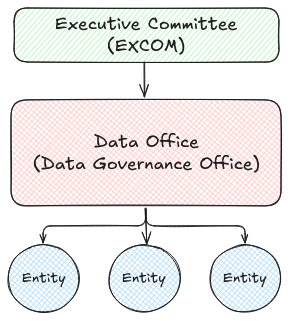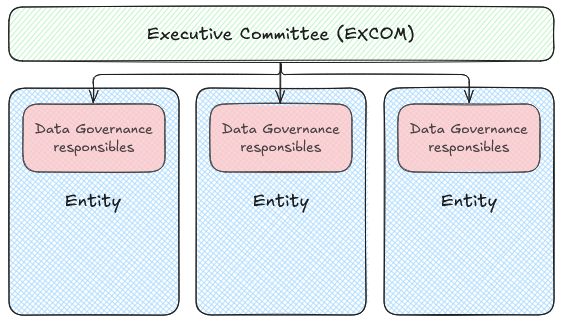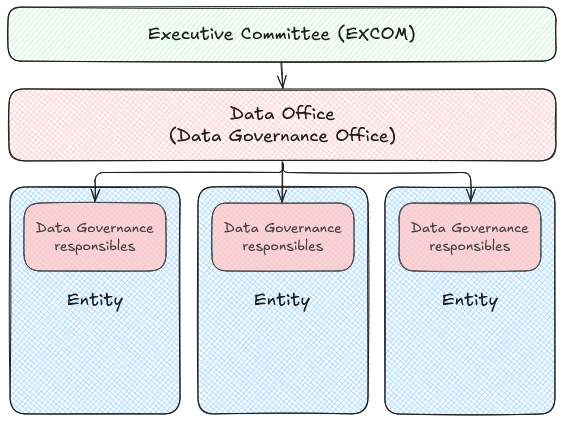Data Governance models
Data Governance models help you structure your efforts and organize your Data Governance activities.
1. Introduction
Implementing Data Governance in a company can be quite the challenge, given the various roles, activities and responsibilities that lie within the scope. Data Governance cannot be implemented blindly or by magic, there is a need to set up an organisation, roles and processes, to apply policies within the company.
The goal of a Data Governance model is to set up an organisation that can achieve Data Governance objectives through processes, roles and activities. By defining the various roles in your Data Governance model, the interactions between these key people in the organisation, and decomposing the Data Governance activities and processes, you can improve Data Management in the company.
2. Centralised model
The most commonly used and easiest model possible to put in place is a centralised Data Governance model. The idea behind a centralised model is to create a global organisation containing the main roles and key people within the same perimeter/department. It can sometimes be called a Data Office (positionned under the responsibility of a Chief Data Officer), or a Data Governance Office.
This centralised organisation has the responsibility to define the company’s Data Governance Strategy that should accompany data practices. This department is usually made of accomplished data practitioners, processes experts or experimented business referents that know the business strategy.
Data policies, Data Governance rules, Data Quality guidelines, or even data sharing patterns are some examples of Data practices related to a Data Governance Strategy. These practices are designed by this central entity, and their applicability into operational departments are directly distributed to operationnal teams in the company.
However, the rigidity of such a centralised model can lead to local workarounds found by entities to solve problematics or the processes elaboration slowness. Failures in bridging gaps between central policies and local practices can lead to data security, data privacy or compliance issues when they are not addressed effectively.
3. Decentralised model
A more difficult and mature model that can be chosen is the decentralised Data Governance model. In this case, strong assumptions are taken regarding the maturity of the company and the data practitioners within it. Data Quality is a known concept for the majority of collaborators, data practices guidelines are shared and understood within the whole company, and teams are autonomous.
Guidelines, good practices and data policies are usually designed by a top-level entity such as the Executive Committee (EXCOM) of the company. Unfortunately, this group of people is rarely proficient on such subjects, and they often iterate with local experts present in the various entities of the company. The clever iterations between these two parts are the only way to design relevant data policies.
Top-level entities also rarely have enough experience or skills to design appropriate data policies or Data Governance rules. This means such a model can only work if this entity can have the support, in both skills and applicability on the field, of the various other entities in the company, that contain the data practitioners experts, the business and data domains responsibles, etc.
The decentralised Data Governance model is not advised to unmature companies that are not ready on Data Governance related subjects. The simple explanation to this statement is that the good execution on the field of such a model requires teams to be professional and to follow data practices guidelines such as documentation, data sharing patterns or even regulatory compliance.
4. Hybrid model
Deploying an hybrid Data Governance model can be a good in-between solution for your company depending on its maturity. Adopting an hybrid model takes a bit of organisation at the beginning, because you need to setup routines and processes between the central entity and the distributed point of contacts. But it can lead to a better control over Data Governance practices in a general way.
Within such routines and processes, you can also imagine have round tables and iterative discussions to adapt the data policies to the reality of the field and the business of the company. This cannot be more concrete than the difficulties and the return of experience the business and their practitioners can communicate during these exchanges. This is an excellent mean to find the best global policy that fits the company needs.
Simple data policies and Data Governance rules can be quickly put in place inside entities, while recolting feedbacks and returns of experience in a short lapse of time. This permits to quickly iterate on what works and what should be approved regarding data policies for the business and the various teams handling data and implementing projects in the company.
Hybrid models are recommended for companies who want quick results, knowing they are not mature with Data Governance and data practices right from the start. With this model, you do not only depend on a centralised task force, but on distributed resources you can steer towards Data Governance goals. On the other hand, they can communicate their expectations regarding business data practices.
5. Conclusion
Choosing and implementing a Data Governance model inside a company can be very difficult, and it is certainly linked to the company’s level of maturity. However, different models exist and they are differently suited given the maturity of your organisation. Centralised, decentralised and hybrid models are three choices that are possible when starting, with their respective pros and cons.
The main thing to remeber about Data Governance models is that they are built on top of people, through roles and responsibilities. Naming these key people, and clarifying their activities and what they can bring to the company through their implication is essential in motivating operational teams, improving data policies, and making data practices more professional in the organisation.


